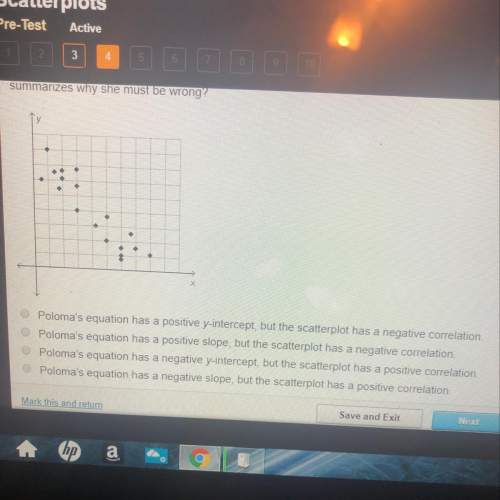
Mathematics, 10.03.2021 23:20 lexirandall19
Which number is a solution of the inequality c greater-than 5? Use the number line to help answer the question.
A number line going from 0 to 10.
2
2.5
5
6.5

Answers: 2
Another question on Mathematics

Mathematics, 21.06.2019 21:30
In a test for esp (extrasensory perception), a subject is told that cards only the experimenter can see contain either a star, a circle, a wave, or a square. as the experimenter looks at each of 20 cards in turn, the subject names the shape on the card. a subject who is just guessing has probability 0.25 of guessing correctly on each card. a. the count of correct guesses in 20 cards has a binomial distribution. what are n and p? b. what is the mean number of correct guesses in 20 cards for subjects who are just guessing? c. what is the probability of exactly 5 correct guesses in 20 cards if a subject is just guessing?
Answers: 1

Mathematics, 22.06.2019 00:40
The point (-7, -24) is on the terminal ray of angle 0 which is in standard position. a student found the six trigonometric values for angle e. the student's answers are shown. which value(s) are incorrect? sin(8) cos(8) 24 tan(0) sin(0)=25 cos(0) -- tan(ⓡ) - - 24 csc(o)=2 sec(0) --25 cot(6) - za csc(o) sec(0) cot(0) done
Answers: 3

Mathematics, 22.06.2019 03:30
Astudent solves the equation for v. start with the original equation. use the square root property. use the division property of equality. use the multiplication property of equality. simplify. which statement explains how to correct the error that was made? the square root property must be applied after all other properties of equality are applied. the multiplication property of equality should have been applied before the division property of equality. the division property of equality should have been applied to move the fraction to the other side of the equation. the square root property should have been applied to both complete sides of the equation instead of to select variables.
Answers: 1

Mathematics, 22.06.2019 04:30
Consider the linear model for a two-stage nested design with b nested in a as given below. yijk=\small \mu + \small \taui + \small \betaj(i) + \small \varepsilon(ij)k , for i=1,; j= ; k=1, assumption: \small \varepsilon(ij)k ~ iid n (0, \small \sigma2) ; \small \taui ~ iid n(0, \small \sigmat2 ); \tiny \sum_{j=1}^{b} \small \betaj(i) =0; \small \varepsilon(ij)k and \small \taui are independent. using only the given information, derive the least square estimator of \small \betaj(i) using the appropriate constraints (sum to zero constraints) and derive e(msb(a) ).
Answers: 2
You know the right answer?
Which number is a solution of the inequality c greater-than 5? Use the number line to help answer th...
Questions




History, 01.09.2020 21:01

History, 01.09.2020 21:01




Mathematics, 01.09.2020 21:01

Physics, 01.09.2020 21:01


History, 01.09.2020 21:01

Mathematics, 01.09.2020 21:01

Advanced Placement (AP), 01.09.2020 21:01

Mathematics, 01.09.2020 21:01

Computers and Technology, 01.09.2020 21:01


English, 01.09.2020 21:01

History, 01.09.2020 21:01





